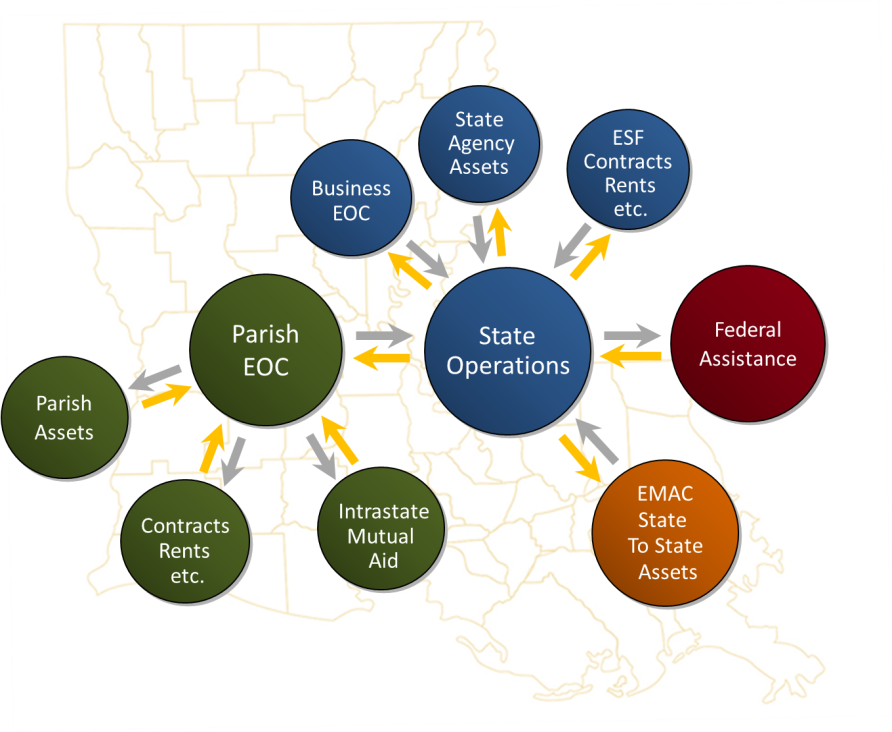Mission Flow

Coordinating Organizations + Structures for Response
Emergencies and disasters begin at the local level using all available Parish resources. When resources at the local level are overwhelmed, the Parish Office of Homeland Security and Emergency Preparedness (OHSEP) requests assistance from other Parishes where there are agreements in place OR through the Intrastate Mutual Aid Compact (IMAC), which provides Parish-to-Parish mutual assistance.
Emergency Management Process
State resources are the next line of defense. When resources are not available at the local level, or additional resources are needed, requests for assistance are made to the State Emergency Operations Center (SEOC) through a web-based emergency management software system called WebEOC.
When State resources are overwhelmed or a particular need is not available through the State, the Governor can request assistance from other States through the Emergency Management Assistance Compact (EMAC).
If further assistance is needed, the Governor can request a Presidential Declaration of Emergency for the event, opening the door for Federal assistance through the Federal Emergency Management Agency (FEMA).
Incident Command System (ICS)
Incident Command System (ICS) provides flexibility and span of control to assign ESFs and other stakeholder resources according to their capabilities to augment and support the response and early stage of recovery. It is a systematic tool used for the command, control and coordination of emergency response. A flexible, scalable response organization, ICS provides a common framework within which people drawn from multiple agencies and disciplines, who do not routinely work together, can effectively work together during response and recovery from emergency or disaster events using standard response and operation guidelines.
The ICS standardized, on-scene, all hazards incident management approach allows for the integration of facilities, equipment, personnel, procedures and communications operating within a common organizational structure. ICS enables a coordinated response among various jurisdictions and functional agencies, both public and private, and establishes common processes for planning and managing resources.
State Emergency Operations Center (SEOC)
The State Emergency Operations Center (SEOC) is the command-and-control center for emergency response. Staffed with GOHSEP employees and State agency representatives, the functions of the SEOC ensure that necessary personnel and resources are available to appropriately respond to an event. The SEOC provides situational awareness to the Unified Command Group (UCG) – the decision-making mechanism for incident response – and coordinates timely assistance in support of local and State stakeholders during natural and manmade crises.
GOHSEP’s SEOC is located at 7667 Independence Blvd. in Baton Rouge, Louisiana 70806.
Important Terms
Situation Report (SitRep)
A SitRep is used to provide updates on an unfolding situation and report critical “on the ground” situation information. SitReps are intended to assist GOHSEP personnel, local Parishes, State agencies and Federal partners in making informed decisions to preserve life, property and the environment in the event of a disaster or emergency.
WebEOC
WebEOC is an internet-based emergency information management application that provides operational details from various government and public safety groups in response to an imminent threat, emergency or disaster. It is the crisis information management system that provides real-time information sharing throughout the State.
WebEOC is used by GOHSEP, local Parishes and State and Federal agencies to monitor and manage activities before, during and after an incident. It can also be used during the planning, recovery and mitigation phases of any emergency.
Emergency Support Functions (ESFs)
State ESF Structure
The State of Louisiana Emergency Operations Plan (EOP) identifies State Emergency Support Functions (ESFs) as the structure for organizing and coordinating State resources by area of function. The ESF structure groups functions most frequently used, helping to ensure efficient and timely delivery of needed assistance to disaster-impacted communities.
Functions are categorized by the type of support or resource provided or managed within the National Incident Management System (NIMS) and its subcomponent, the Incident Command System (ICS). In addition to ESFs identified within the NIMS structure, Louisiana has included Military Support as an ESF.
NIMS, created by the U.S. Department of Homeland Security (DHS), along with the ICS is the Nation’s standardized approach to emergency and disaster incident management.
For additional discussion on State ESFs, see the State ESFs section of this website.
ESF #1 Transportation
ESF #2 Communications
ESF #3 Public Works + Engineering
ESF #4 Firefighting
ESF #5 Emergency Management
ESF #6 Mass Care, Emergency Assistance, Housing + Human Services
ESF #7 Resource Support
ESF #8 Public Health + Medical Services
ESF #9 Search + Rescue
ESF #10 Oil + Hazardous Materials Response
ESF #11 Agriculture + Natural Resources
ESF #12 Energy
ESF #13 Public Safety + Security
ESF #14 Long-Term Community Recovery + Mitigation
ESF #15 External Affairs
ESF #16 Military Support + Civil Authorities
ESF #17 Cyber Security
Federal ESF Structure
The Federal Government – through the National Response Framework – also identifies an ESF system to align Federal support by function. Emergency Support Functions provide the structure for coordinating Federal interagency support for a federal response to an incident when Federal support is needed and authorized. Like the State ESFs, they are mechanisms for grouping functions most frequently used to provide Federal support to States, both for declared disasters and emergencies under the Robert T. Stafford Disaster Relief and Emergency Assistance Act (Stafford Act) and for non-Stafford Act incidents.
For additional discussion on Federal ESFs, see the Federal ESFs section of this website.
ESF #1 Transportation
ESF #2 Communications
ESF #3 Public Works + Engineering
ESF #4 Firefighting
ESF #5 Emergency Management
ESF #6 Mass Care, Emergency Assistance, Housing + Human Services
ESF #7 Logistics Management + Resource Support
ESF #8 Public Health + Medical Services
ESF #9 Search + Rescue
ESF #10 Oil + Hazardous Materials Response
ESF #11 Agriculture + Natural Resources
ESF #12 Energy
ESF #13 Public Safety + Security
ESF #14 Long-Term Community Recovery
ESF #15 External Affairs


